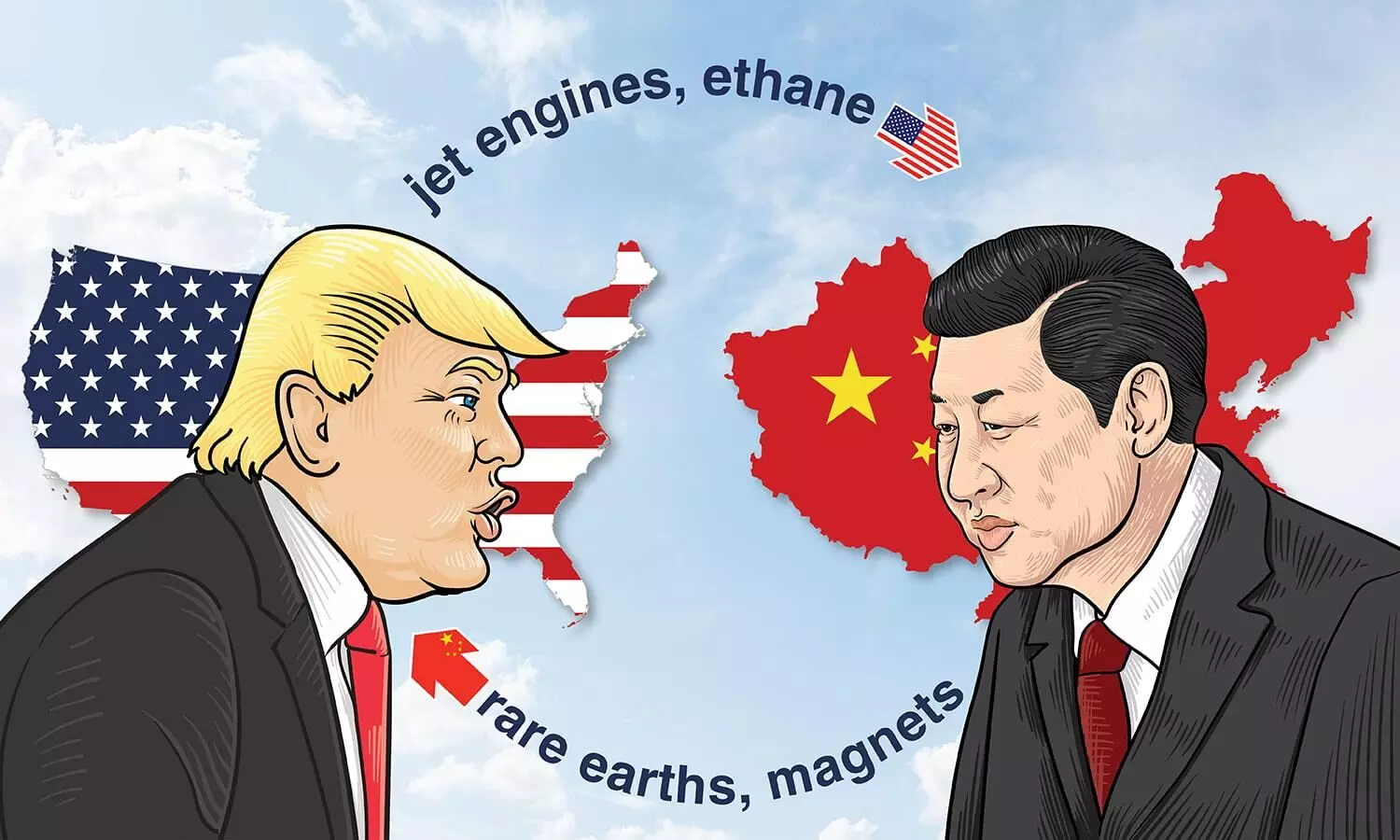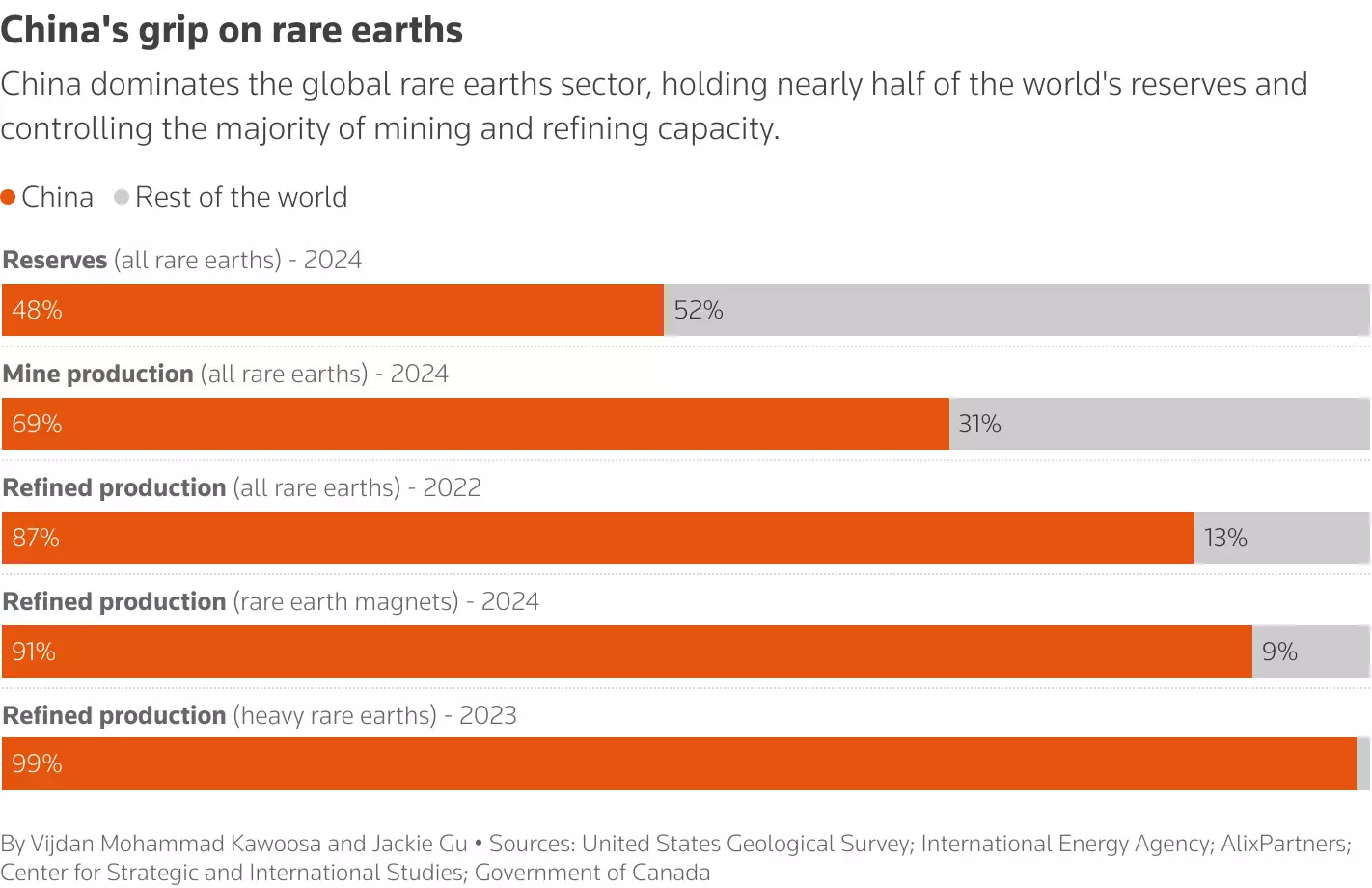
Who's really bleeding in the US-China tariff war?
Washington and Beijing strike a fragile truce in London, easing rare earth curbs and export controls—but with limits in place, global trade stability remains uncertain.

After months of retaliatory tariffs, suspended exports, and mounting diplomatic tensions, President Donald Trump has announced that a new trade deal with China is “done.” The declaration, made Tuesday night following two days of intensive negotiations at Lancaster House in London, could signal a major reset—or simply a temporary reprieve—in the prolonged and complex US-China trade dispute.
The provisional agreement, pending final approval from both US President Donald Trump and Chinese President Xi Jinping, outlines a significant concession: China will resume full exports of rare earth minerals and magnets to the United States. These materials are vital to key American industries, including defence, automotive, and electronics, as they are used in everything from smartphones and electric vehicles to missile systems and fighter jets.
In return, the United States is expected to ease restrictions on certain industrial exports to China, including commercial jet engines, ethane (a critical petrochemical feedstock), and specialised manufacturing components. However, restrictions on advanced semiconductor technologies will remain largely unchanged.
Crucially, China is imposing a six-month limit on rare-earth export licenses issued to US companies. This time-bound commitment introduces a “ticking clock” into the deal, creating lingering uncertainty and reinforcing China’s leverage over strategic material flows. The short-term nature of the arrangement could have major implications for global supply chains, particularly in sectors like air cargo and high-tech manufacturing, where just-in-time delivery of high-value components is essential.

The announcement comes at a particularly sensitive moment. The US auto industry was approaching a production standstill after China halted shipments of critical magnets used in electric motors, windshields, and vehicle doors. With China responsible for over 70% of global rare earth processing, American automakers faced limited alternatives and increasingly urgent supply shortages.
Following two days of negotiations, both sides agreed to a framework to resume rare earth exports and begin implementing key elements of an interim deal initially struck in Geneva last month. Export licenses—suspended by Beijing in April amid rising tensions—will now be temporarily restored for six months, granting US companies limited but immediate access to critical inputs.
President Trump confirmed the development in a post on his Truth Social platform on June 11:
The "55% tariffs" figure cited by Trump is understood to reflect a combination of levies: the 10% global baseline tariff implemented under his administration, a pre-existing 25% tariff on Chinese industrial goods first imposed in 2020, and a more recent 20% tariff targeting imports linked to fentanyl trafficking. In contrast, China has reportedly agreed to impose a 10% flat tariff on US goods entering its market.
The US President also posted on Truth Social, “Adding to the China readout, President XI and I are going to work closely together to open up China to American Trade. This would be a great WIN for both countries!!!”
This rebalancing, while offering short-term economic relief, does not signal a comprehensive resolution. Instead, the six-month license limit and selective relaxation of trade restrictions underscore the deal’s fragility—and the continuing strategic competition between the world’s two largest economies.
The framework also appears to address another thorny issue: Chinese students. In recent months, Washington had stepped up visa denials for students pursuing degrees in science, engineering, and AI-related fields, particularly those linked to Chinese state institutions or the Communist Party.
Trade opens, tensions persist
Strategic materials and high-tech exports remain at the heart of US-China trade friction. April’s export ban on rare earth magnets from China—used in EVs, missiles, wind turbines, and jet engines—exposed how vulnerable US industries remain despite efforts to diversify. The London agreement restores access for now, but only under six-month licenses, keeping pressure high and planning horizons short.
Alongside this limited reprieve, Washington has agreed to relax select industrial export restrictions—covering jet engines, ethane, and some manufacturing inputs. But the core tech decoupling continues. Semiconductor tools, chip design software, and high-performance computing components remain tightly controlled. COMAC’s C919 jetliner, aimed at challenging Boeing and Airbus, remains stalled by these controls—its supply chain still reliant on US and European firms like GE and Honeywell. COMAC’s C919 uses an engine developed by CFM International, a joint venture between US-based GE Aerospace and France’s Safran.

The standoff over semiconductors is particularly stark. The US and its allies continue to block China’s access to critical chipmaking gear. In response, Beijing has poured state funds into building domestic capacity. Yet analysts say China still depends on Western tools to produce advanced chips used in AI, military tech, and cloud computing. The US is now reportedly moving to further restrict Chinese access to memory technologies like High Bandwidth Memory (HBM) and Dynamic Random-Access Memory (DRAM), while blacklisting companies suspected of bypassing controls through third countries.
Amid this backdrop, trade data paints a sobering picture. China’s overall exports rose 4.8% in May 2025, but exports to the US fell nearly 10%, while Chinese imports from the US dropped 7.4%. That pushed China’s trade surplus with the US to $103.2 billion—a widening gap that underscores how tariffs are distorting trade, not balancing it.
While China’s exporters are adjusting and diversifying, US manufacturers and farmers face higher costs, delayed inputs, and shrinking market access. The London deal may ease immediate bottlenecks, but without deeper structural reform, the economic pain—especially in the US—could deepen in the months ahead.
South Korea: Resilient amid turbulence
While the US and China dominate headlines, South Korea is quietly thriving despite global uncertainty. Its performance in early June suggests that countries not locked in direct confrontation may be among the biggest beneficiaries of supply chain realignment.
According to the Korea Customs Service, South Korean exports surged 5.4% year-on-year in the first ten days of June to $15.48 billion. Semiconductor exports alone jumped 22%, powered by surging global demand for HBM and DRAM chips used in AI data centres and mobile devices.
Vehicle shipments also rose 8.4%, while exports to the US and EU grew 3.9% and 14.5%, respectively. Even exports to China, South Korea’s largest trading partner, increased by 2.9%, showing signs of cautious optimism.
However, imports jumped by 11.5%, widening the trade deficit to $1.78 billion. Notably, South Korea imported more semiconductors, liquefied natural gas, and industrial machinery—highlighting its deep integration into both US- and China-facing supply chains.
With global manufacturers diversifying production hubs, South Korea’s advanced infrastructure, regulatory clarity, and skilled workforce position it as a stable alternative in an era of geopolitical disruption. However, despite efforts to maintain neutrality, South Korea may be forced to navigate a more complex operating environment if the US-China dispute continues. The global chip supply chain is deeply interconnected, and any disruption in component or tool access tends to have cascading effects across regions.
Vietnam: Another rising star amidst the tariff war
Vietnam's export boom to the US is intensifying trade tensions with Washington, even as Hanoi scrambles to avoid sweeping tariffs. In May 2025, Vietnam’s trade surplus with the US surged to $12.2 billion, a 42% year-on-year increase, with exports hitting a post-pandemic high of $13.8 billion, according to news updates. This pushed Vietnam ahead of Mexico in the US trade surplus rankings, behind only China and the EU.
Much of the spike is attributed to front-loading by exporters trying to beat a looming 46% “reciprocal” tariff proposed by President Trump. At the same time, Vietnam’s imports from China rose 21%, raising concerns that Chinese goods are being rerouted through Vietnam to avoid US duties.
Washington has accused Vietnam of acting as a transhipment hub for Chinese products and has submitted a long list of demands in ongoing tariff talks, including cutting back on Chinese inputs. Although Hanoi has responded with crackdowns and pledges to buy more US goods, the growing surplus may undermine its efforts to avoid penalties.
Vietnam now finds itself at the centre of a global supply chain realignment, hosting major manufacturing for US multinationals like Apple, Intel, and Nike, as well as Chinese suppliers. The country’s role is expanding—but so is the scrutiny.
A temporary pause, not a resolution
The recent US-China trade agreement may ease some pressure on trans-Pacific air cargo routes, especially for electronics and automotive shipments.
The International Air Transport Association (IATA) has yet to release June figures, but airfreight volumes could be affected with the new changes in the US-China tariffs.
Moreover, aircraft manufacturers like Boeing, Airbus, and COMAC could see more stable production timelines if the agreement holds—potentially impacting freighter availability and maintenance, repair, and overhaul (MRO) schedules.
The London framework marks a notable de-escalation between the world’s two largest economies—but it remains a truce, not a treaty. The six-month limit on China’s rare earth export licenses, unresolved semiconductor restrictions, and conditional access for Chinese students reflect ongoing mistrust.
For now, the deal offers short-term relief for industries and supply chains. But without a longer-term framework based on transparency, reciprocity, and mutual restraint, the calm may be temporary.
Key structural issues—such as intellectual property rights, market access, data controls, and subsidies—remain unaddressed. And the built-in expiration of export licenses could trigger renewed disruption if no progress is made.
While the partial restoration of rare earth supplies and easing of select export controls mark a cooperative step, the broader US-China rivalry over technology and strategic resources is set to persist beyond 2025.

